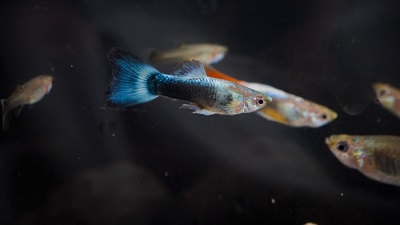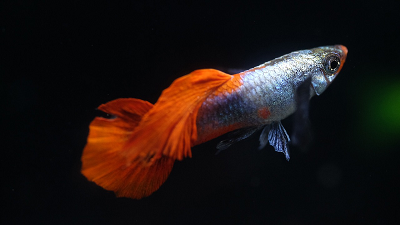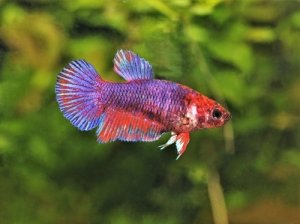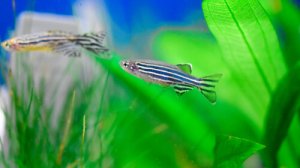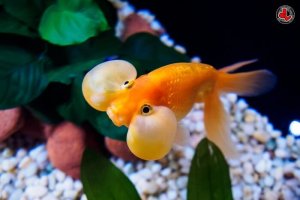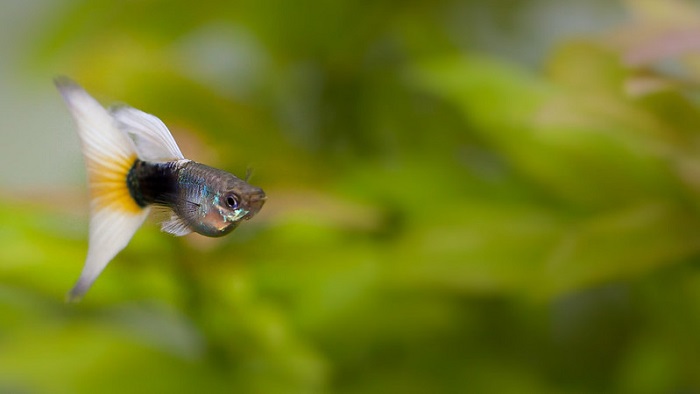
The Tuxedo Guppy is one of the most interesting color variations of this freshwater species, what makes it even more fascinating is the fact that the females exhibit similar bright colors and markings.
The Tuxedo guppy will have a lighter color on the top half of the body, with a much darker bottom half-color, the colors can range anything from black and white, to red and white, and many more. Tuxedo Guppies, like most other fancy guppy breeds, are robust, and interesting fish that are mostly sociable and calm, as well as easy to care for.
Though the rare colors such as Tuxedo and Koi Tuxedo Guppies are usually chosen by more experienced aquarists, they are perfect for beginners, and might just take some time to find.
On that note, let us explore some more fascinating facts on the Tuxedo Guppy color strain, as well as look at some vital care tips.
Breed Overview
| Origin | South America, Germany. |
| Lifespan | 1-3 years, 5 years with optimal care. |
| Size | Males 1.5– 3.5cm (0.6 – 1.4 Inches), Females 3–6 cm (1.2–2.4 Inches). |
| Colors | Black, White, Gold, Blonde, Pink, Yellow, Red, Orange, Blue, Green. |
| Food | Omnivores |
| Tank Size | 10 – 20 Gallons, for 3 Guppies. |
| Temperament | Peaceful, Social, Shoaling, Intelligent. |
| Water Temperature | 78–82°F (25.5–27.8°C). |
| Water pH | 5 – 8.5. |
| Difficulty Level | Beginner Easy, ideal for Collectors, Breeders, and Enthusiasts. |
Species Summary
Guppies (Poecilia reticulata), in general, originate from South America, though the Tuxedo Guppy was initially bred in captivity in Germany. Guppies are one of the world’s most popular freshwater fish species, that are available all over today, with new color strains and variations being bred consistently. The Tuxedo guppy also known as the Tuxedo fish, blackfish, or Koi Tuxedo guppy, is an elegant variation with contrasting colors.
The top half of the body will usually be a lighter color, with the bottom half of the body black or a darker color. It is a striking variety of Guppy and even the females in this color variation have very vivid color markings.
Tuxedo Guppy Fish Color Variations
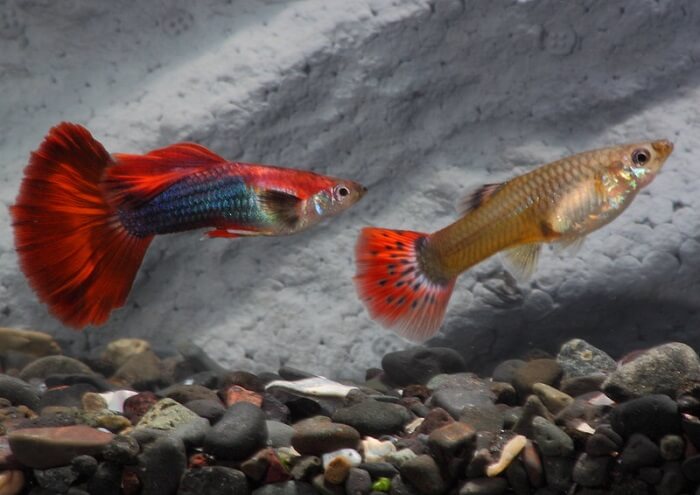
In most Tuxedo Guppies the top half of the body and head will be a different color, usually lighter than the bottom half. Initially, the Tuxedo guppy was bred with a very dark almost electric Tuxedo tail and lower body, and a red or brown to silver upper body, though today the colors may differ.
There are mainly two types of Tuxedo Guppies:
| 1. Basic Tuxedo Colors
Your basic Tuxedo Guppy will have a lighter-colored top half and a darker-colored bottom half. Tuxedo Guppies come in a large variety of colors such as; Yellow, Gold, Blonde, Black, White, green, orange, red, and Blue. |
2. Koi Tuxedo Colors
The Koi Tuxedo Guppy is an uncommon variety with vivid orange and dark blue colors in the bottom half and fins and white in the rest of the body. Sometimes the entire color pattern scheme may be displayed over the whole body of male Koi Tuxedo Guppies and their fins. |
|
|
|
Most Tuxedo Guppies will feature the Delta tail variation, though they have been bred with other tail variations such as the Veil Tail, Round Tail, Lyre Tail, Flag Tail, and Fan Tail, among others.
Another interesting fact is that most Tuxedo Guppy females will display similar intense colors to the males, though not as extravagant. Females are generally much larger than males, with a rounder body, whereas males are more streamlined with larger flowing tails.
Lifespan And Size Of Tuxedo Guppies
The Tuxedo Guppy has the same size and lifespan as most fancy Guppies. Guppies will mostly have a lifespan of around 1-3 years, though there have been cases where they can live up to 5 years. Male Guppies are smaller than females at between 1.5– 3.5cm (0.6 – 1.4 Inches), in size and females are 3–6 cm (1.2–2.4 Inches).
Temperament And Behaviour
Guppies tend to each have an individual personality of their own, while generally, they are very peaceful and sociable fish. Guppies enjoy schooling and can easily get stressed when they are alone. It is advised to keep them in one male to two or three females ratio. Be warned though they are very eager breeders and if you would like to avoid this, I recommend keeping only females, or you can try males, but it may be risky as they may fight.
General Care Of Tuxedo Guppies
One thing that I love about Guppies, and maybe the reason why they are so popular, is how easy they are to care for. They are hardy and easily adapt to most water conditions. Guppies are ideal for beginners, and even for avid aquarists that enjoy the rarer color variations such as the Tuxedo guppy.
Did you know that Guppies can tolerate saline of up to 150%, they can be kept in a marine aquarium, however, this is not the ideal living condition for them, as they prefer slightly brackish freshwater.
Creating An Aquarium For Guppies
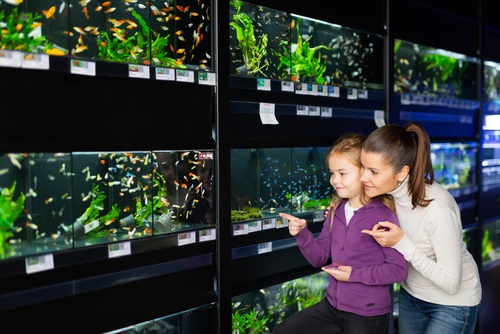
I personally usually prefer a more natural habitat for Guppies, that mimics their natural small streams and water bodies in their natural habitat. Though you can decorate your tank to your heart’s content as Guppies love plenty of plants and toys to keep them entertained. With the right water conditions and a healthy diet, they will easily thrive and may live longer than expected.
- Tank Size – 10 to 20 gallons for three Guppies, and 5 gallons per additional fish.
- Water Conditions – Water with a pH of between 6.5 and 8.5 is ideal, with one tablespoon of salt per 5 gallons. Temperatures should be between 78–82°F (25.5–27.8°C, are ideal, and never below 68 ̊ F (20 ̊ C), which is tolerable but not ideal.
- Filtration – Choose a filter that is less powerful with a light current, such as a hang-on back, or sponge filter. Guppies are relatively clean and do not generate much waste.
- Light – Guppies sleep at night and need a clear indication of day and night. Therefore, LED light would be best during the day, or indirect sunlight.
- Heat – You can use a 50 watts per 10-gallon tank heater, as Guppies prefer a more tropical climate. If you live in a warm area, you can get away without a heater.
Decorating Your Tank
Guppies get bored quickly and they do enjoy a well-planted tank with ample swimming space, as well as some hiding spots.
- Substrate – Substrates such as sand, small gravel, and crushed coral are very easy to clean and will not hold debris. You could even consider Aqua soil, though with Aqua soil you may need additional minerals. Choose good contrasting color substrates to show off the vibrant colors of your Tuxedo Guppies.
- Ornaments And Toys – Guppies will enjoy toys and hiding spaces with their playful nature, anything from caves and castles, Rocks, and Driftwood, to PVC pipes and ceramic pots. Just ensure that your tank décor is safe with no sharp edges that could cause an injury.
Plants
Plants both silk synthetic and live plants are ideal. Live plants have the additional advantage of cleaning and oxygenating your tank water. Live plants similarly offer good hiding spots for guppy fry, as I have mentioned Guppies will easily breed in your communal aquarium, but unfortunately try to eat their young. Some Good plants to consider are;
- Mosses –Java Moss, Flame Moss, or Christmas Moss.
- Floating Plants –Water Sprites, Water Wisteria, Guppy Grass, and Water Lettuce.
- Rooted Plants –Anacharis, java ferns, Anubias, Amazon sword, Hornwort, Cryptocoryne, and Moneywort.
An interesting fact, the Pothos plant, a regular houseplant, can be placed with its roots floating in your tank growing out of the tank, it is the best way to naturally lower harmful nitrates in your tank.
Tank Equipment And Maintenance
Some basic tank equipment can help with cleaning and maintaining your tank in peak condition;
- A gravel vacuum is perfect for easy cleaning.
- Your siphon hose is necessary for weekly water changes, which will need to be done.
- Aquascape tools allow you to easily rearrange your tank décor and also remove dead plants and debris.
- A testing kit is crucial to keep water parameters at optimal levels.
Regular tank maintenance and water changes of at least 25% of the tank water will be necessary, while you should similarly ensure that you clean out all uneaten foods immediately or keep a few bottom-feeding companions to do the job.
Choosing And Introducing Your Tuxedo Guppies
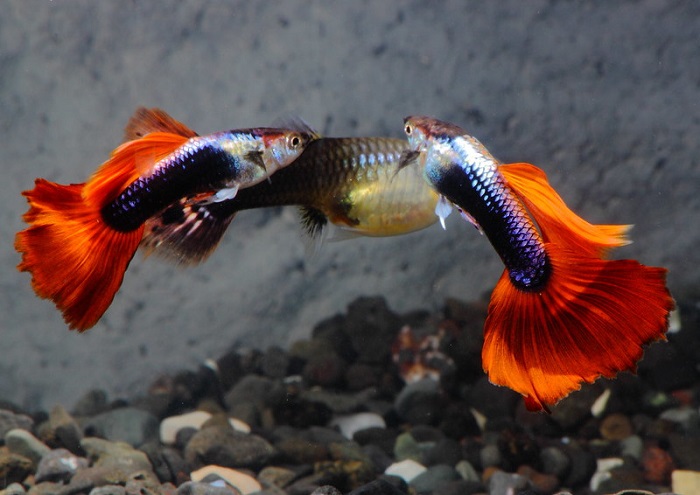
After you have set up your aquarium and properly cycled the water to get optimal conditions, you are now ready to choose and add your Tuxedo Guppies.
Choosing Your Guppies
You may have to do some research on specific breeders or pet stores that have Tuxedo Guppies in the color that you prefer. Choose a healthy and active fish, that has no visible signs of disease or damage to the body, with bright and clear eyes, and no skin residue or bloated tummies. You will have to choose one or more companions, the best ratio being two to three females per male guppy.
How To Place A Fish In A Tank
It’s best to switch aquarium lights off first before introducing new fish and to feed tank mates before adding your Guppies. Place the bags with the fish in the tank to float for 20 minutes to acclimate, and then you can replace two to three cups of water from the bag with tank water at intervals of 15 minutes. Now you are ready to add your new fish, taking care not to allow the water from the bag to run into the tank. Lights can be turned back on after two to three hours.
One very important factor when adding any new fish or plants to a communal tank that already has fish and plants is to first quarantine the new fish or plants in a separate tank if you can, to reduce the risk of pest or illness contamination.
Suitable Tank Mates For Guppies
Guppies are peaceful shoaling fish and should be kept with fish that are similar in nature and size, as they can easily become prey for larger more aggressive fish. Guppies are quite adaptable to most water conditions, however, you will need to consider the temperature and water condition requirements of any new tank mates.
A few species that do well with Guppies include:
- Pygmy And Cory Catfish – Small bottom feeders.
- Endlers – Smaller than Guppies, but close relatives.
- Kuhli Loaches – Also bottom dwellers, nocturnal though.
- Platies – Very Colorful Live bearing fish.
- Neon, Ember, And Black Neon Tetras – They are small, fast, and intelligent.
- Galaxy And Harlequin Rasboras – Peaceful Shoaling fish.
- Peacock Gudgeons – Peaceful carnivores that will keep your guppy fry population down.
- Bristlenose Plecos – Small bottom feeders that help to clean the tank.
- Mollies – Larger, but peaceful and available in many colors.
- Invertebrates – These smaller invertebrates such as Nerite snails, Cherry, and Amano shrimps are ideal mates for Guppies.
Feeding Your Tuxedo Guppies
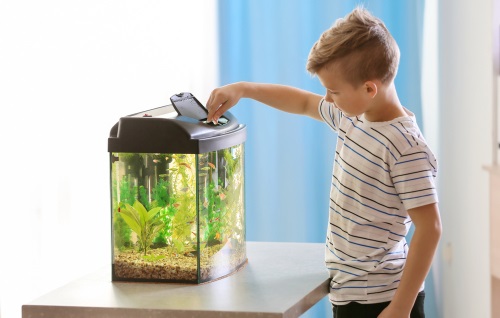
Guppies eat small amounts and they are slow eaters that enjoy a variety of foods. Being Omnivores, they will need both meat-based and plant-based foods. It is recommended to feed Guppies a pinch of food twice a day, morning and evening, and to remove all leftover foods.
Guppy Foods;
- Meat-Based Foods – You can feed live or freeze-dried Brine shrimp, daphnia, insect larvae, and Bloodworms, or cooked minced beef, and cooked egg yolk.
- Plant-Based Foods – Blanched greens such as Kale spinach, lettuce, and zucchini are ideal, though you can also feed broccoli and cauliflower that is cooked. Blanched Greens and vegetables; Cucumber, Shelled Peas, Lettuce, Sliced Zucchini, Broccoli, Cauliflower, and Kale.
- Flakes And Pellets – Your Guppies will need a staple of high-quality fish flakes or granules that are designed for the species of fish. Quality flakes, pellets, granules, and algae wafers can be fed as a balanced meal.
Health Issues In Guppies
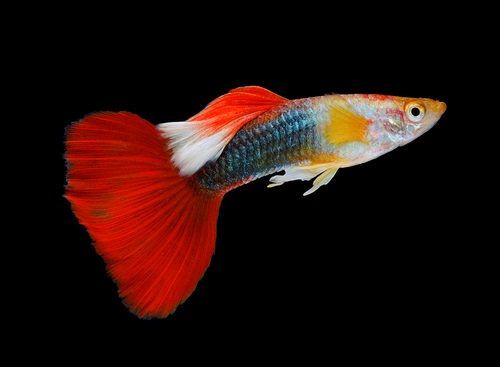
Regarding health issues, most fancy breeds of Guppies such as the Tuxedo Guppy may have inherited disorders if there are recessive genes in both parents for skin, or eye diseases among other issues. On the other hand, healthy-bred Guppies are hardy and tolerant, and will not easily get sick. Though for good measure, here are a few common freshwater health concerns to look out for;
1. White Spot Disease/Ich
A parasitic condition causes white spots on the body of the fish because of poor water conditions, stress, or contracting from new fish or plants.
- Treatment: You will need a clean separate tank for the sick fish with higher temperatures and you can use Malachite Green, Formalin, and aquarium salts.
2. Fin And Tail Rot
A bacterial infection caused by a fungus in dirty water, or from Ammonia burns. It causes patches and tears in the fins of your fish.
- Treatment: Quarantine in clean water is needed, with antibiotics, and fungal medication.
3. Swim Bladder Disorder or Dropsy
When there is an infection of the swim bladder it keeps your fish afloat, because of stress, poor diet, or poor water conditions. The fish will become lethargic, have difficulty remaining upright, and lose its appetite.
- Treatment: This condition is rare in Guppies, but can be treated with proper water conditions, high temperatures, and regular water changes.
4. Columnaris & Mouth Fungus
The condition is infectious, a bacterial fungus causing cloudy patches on the body and mouth of your guppy.
- Treatment: ill fish have to be quarantined and Chemical medication, along with aquarium, and mineral salts may be needed.
5. Gill Flukes
One of the more common diseases among Guppies. Small white worms in the gills cause difficulty breathing. They are usually contracted from infected fish or poor water conditions.
- Treatment: Most vets and pet stores have specific medication to help with Gill Flukes.
Disease Prevention
Most diseases and pests in freshwater fish are caused by three aspects;
- Poor diet.
- Poor water conditions.
- Infection from new fish or plants.
By feeding proper quality food and keeping your tank clean, and ammonia levels down, you are already doing as much as you can to keep your fish healthy. Keep an eye on any new plants or habitats, and quarantine them first before adding them to your tank.
Breeding Tuxedo Guppies
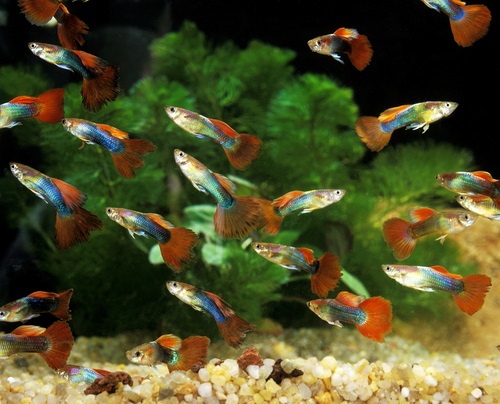
Whether you like it or not, if you have male and female Guppies housed together, eventually, they will breed, unfortunately, they will also eat their young. Guppies are quite eager to breed, the females are live-bearing giving birth to their young, and they are similarly quite picky about the males they choose to mate with if given a choice. One female may mate with several males and can give birth to over 20 young fry.
Guppies have quite an intricate mating and birthing process which you can read more about in our “Your Aquarium Place guide ‘How do Guppies Mate?’”.
Though to touch on the subject, if you would like to breed with your Guppies, I would advise getting Tuxedo Guppies in similar colors, three females per male.
You will need a separate breeding tank with plenty of floating and bottom floating plants for the fry to hide. The water needs to be clean, and slightly higher in temperature, and you can add males and females until mating has taken place, where only the females will be left in the tank.
After birthing, which can take several hours to a day, the female must be removed to protect the young fry. The young fry is usually dependent from birth and can be fed the next day with baby brine shrimp and some cooked spinach leaves.
Should you not want more Guppies, your only other choice is to keep same-sex Guppies, preferably females, or to allow the Guppies and other tank inhabitants to eat the fry, which is essentially what will happen if they are left in a communal tank.
To Conclude
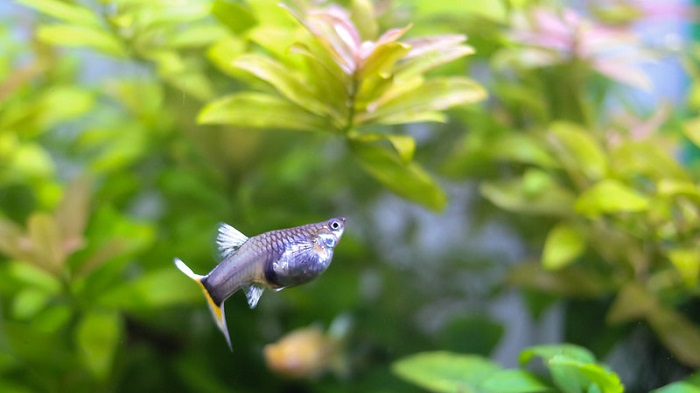
Tuxedo Guppies are one of the most fascinating color strains in the guppy species, with many color options available. They are relatively easy to care for and breed, if you would like to. I find that they are suitable for both beginners and much sought after by guppy enthusiasts and collectors from all over the world.


